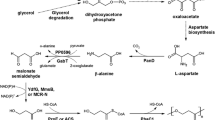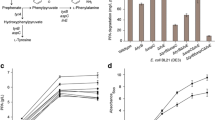Abstract
We examined the expression of the phosphoenolpyruvate carboxylase (PEPC) gene from marine bacteria in Escherichia coli using codon optimization. The codon-optimized PEPC gene was expressed in the E. coli K-12 strain W3110. SDS-PAGE analysis revealed that the codon-optimized PEPC gene was only expressed in E. coli, and measurement of enzyme activity indicated the highest PEPC activity in the E. coli SGJS112 strain that contained the codon-optimized PEPC gene. In fermentation assays, the E. coli SGJS112 produced the highest yield of oxaloacetate using glucose as the source and produced a 20-times increase in the yield of malate compared to the control. We concluded that the codon optimization enabled E. coli to express the PEPC gene derived from the Glaciecola sp. HTCC2999. Also, the expressed protein exhibited an enzymatic activity similar to that of E. coli PEPC and increased the yield of oxaloacetate and malate in an E. coli system.



Similar content being viewed by others
References
Millard, C. S., Chao, Y. P., Liao, J. C., & Donnelly, M. I. (1996). Applied and Environmental Microbiology, 62, 1808–1810.
Nimmo, H. G. (2000). Trends in Plant Science, 5, 75–80.
Uedan, K., & Sugiyama, T. (1976). Plant Physiology, 57, 906–910.
Kwon, Y. D., Kwon, O. D., Lee, H. S., & Kim, P. (2007). Journal of Applied Microbiology, 103, 2340–2345.
Kwon, Y. D., Lee, S. Y., & Kim, P. (2008). Bioscience, Biotechnology, and Biochemistry, 72, 1138–1141.
Hanning, G., & Makrides, S. C. (1998). Tibtechnology February, 16, 54–60.
Sorensen, H. P., & Mortensen, K. K. (2005). Journal of Biotechnology, 115, 113–128.
Hale, R. S., & Thompson, G. (1998). Protein Expression Purification, 12, 185–188.
Zhou, Z., Schnake, P., Xiao, L., & Lal, A. A. (2004). Protein Expression Purification, 34, 87–94.
Wu, X. L., Jornvall, H., Berndt, K. D., & Oppermann, U. (2004). BBRC, 313, 89–96.
Brown, N. A., Sharma, S., Sobott, F., Loenarz, C., Oppermann, U., & Gileadi, O. (2008). Protein Expres Purification, 59, 94–102.
Feng, Z., Zhang, L., Han, X., & Zhang, Y. (2010). World Journal of Microbiology and Biotechnology, 26, 898–901.
Yoon, S. H., Lee, S. H., Das, K., Ryu, H. K., Jang, H. J., Kim, J. Y., et al. (2009). Journal of Biotechnology, 140, 218–226.
Corpet, F. (1988). Nuclear Acids Research, 16, 10881–10890.
Sambrook, J., & Russell, D. W. (2001). Molecular cloning: a laboratory manual (3rd ed.). USA: New york.
Kodaki, T., Katagiri, F., Asano, M., Izui, K., & Katsuki, H. (1985). Journal of Biochemistry, 97, 533–539.
Wang, D., Qiang, L., Wangliang, L., & Xing, J. (2009). Enzyme and Microbial Technology, 45, 491–497.
Lee, K. H., Park, J. H., Kim, T. Y., Kim, H. U., & Lee, S. Y. (2007). Molecular Systems Biology, 3, 149.
Villaverde, A., & Carrio, M. M. (2003). Biotechnology Letters, 25, 1385–1395.
Ventura, S., & Villaverde, A. (2006). Trends in Biotechnology, 24, 179–185.
Irwin, B., Heck, J. D., & Hatfield, G. W. (1995). Journal of Biological Chemistry, 270, 22801–22806.
Peter, K. M., & Philippe, R. (1998). Physiology Plantarum, 103, 132–138.
Rintze, M. Z., Erik, D. H., Wouter, A. V. W., Pieter, D. W., Cor, D., Aaron, A. W., et al. (2008). Applied and Environmental Microbiology, 74, 2766–2777.
Zhang, X., Wang, K. T., Shanmugam, K. T., & Ingram, L. O. (2010). Applied and Environmental Microbiology, 77, 427–434.
Acknowledgments
This work was supported by the National Research Foundation of Korea Grant funded by the Korean Government (MEST) (NRF-C1ABA001-2010-0020501).
Author information
Authors and Affiliations
Corresponding authors
Rights and permissions
About this article
Cite this article
Park, S., Pack, S.P. & Lee, J. Expression of Codon-Optmized Phosphoenolpyruvate Carboxylase Gene from Glaciecola sp. HTCC2999 in Escherichia coli and its Application for C4 Chemical Production. Appl Biochem Biotechnol 167, 1845–1853 (2012). https://doi.org/10.1007/s12010-012-9730-8
Received:
Accepted:
Published:
Issue Date:
DOI: https://doi.org/10.1007/s12010-012-9730-8




